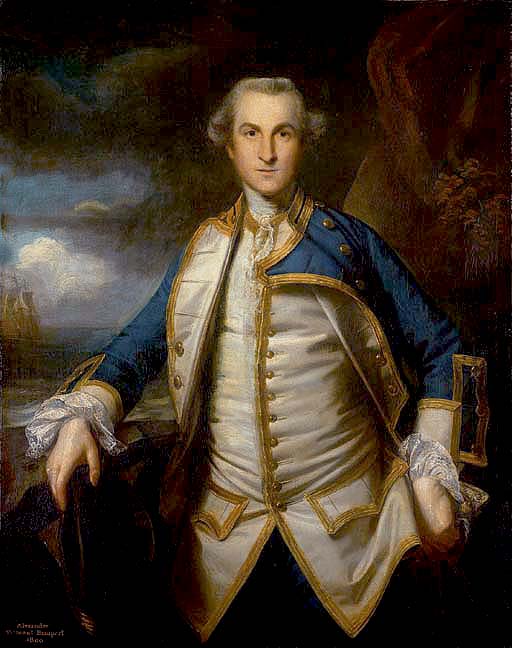

Thomas Luny
The Battle of Raz de Sein
Oil on canvas, signed and dated 'Luny 1834' lower left
Image size: 15 ¼ x 20 ½ inches (39 x 52 cm)
Hand made giltwood frame
Provenance
The Parker Gallery, London
Private collection, England, and by descent.
This dramatic scene throws the viewer straight into the heart of a naval battle between the British ship HMS Mars and the French Hercule. The scene is only lit from two sources - one being the tranquil moon, and the other being violent flashes of canon fire between the two fighting ships. The moon penetrates from behind a thick cloud cover, accentuating the darkness and moody atmosphere of the work. It is an incredibly tense and atmospheric piece, truly demonstrating Luny's talents as a painter of marine battle scenes.
The 74-gun third-rate ship of the line Mars was built in the Deptford docks and launched on the 25th October 1794. She was initially assigned to the Channel Fleet, and on the 12th April 1798 sailed from St. Helens, Isle of Wight, with the Admiral Lord Bridport's squadron bound for Brest.
Nine days later, whilst cruising in company with H.M.S. Ramillies and two frigates, the crew sighted two French vessels and an enemy warship and gave chase. Hercule attempted to escape through the Passage
du Raz, but the tide was running in the wrong direction, and she was forced to anchor, giving the British the chance to attack at close quarters.
After three hours of pursuit Mars brought the 74-gun Hercule to action. The two ships were of equal force, both seventy-fours, but Hercule was newly commissioned; They swiftly became entangled because of fouled anchor cables, and they opened fire on one another at 10:30 pm.
Thus entangled and with sides rubbing together, both captains ordered their ships to pour fire into the other. The situation was such that many cannons on both ships could not be run out, and instead had to be fired from inside, so that the ships sides were much burnt and quite blackened.
After a vicious engagement lasting two hours of bloody fighting at close quarters, Hercule could no longerwithstand the attack and struck her colours shortly after midnight. The damage to both ships was
substantial and loss of life was high. Having lost — by her own officers' estimate — 290 men killed and wounded.
On Mars, 31 men were killed and 60 wounded, including her captain, Alexander Hood, (Image attached) mortally wounded in the thigh – he had been cut in the femoral artery. He is said to have died just as
the sword of the French captain Louis Lhéritier was being put in his hand. Captain Louis Lhéritier of Hercule was wounded by sabre and spike leading his boarding party
For Napoleon this was a huge embarrassment as the Hercule was on her maiden journey and just 24 hours out of port.
The damaged Hercule was taken back to Plymouth and repaired at a cost of £12,500, so extensive was the damage caused by the Mars' broadsides. She was eventually commissioned into the Royal Navy, retaining her original name, but with the added HMS Hercule.
Thomas Luny
Born in Cornwall, Thomas Luny was an English artist who primarily painted maritime scenes and seascapes.
Leaving for London in 1759, Luny became the apprentice of Francis Holman, a marine painter famous for his patriotic scenes of sea battles. Here, Luny developed his practice, with the lasting impressions left by Holman evident in Luny’s later maritime works through compositional and stylistic preferences. Luny temporarily left Holman’s studio in September 1777 to travel around France and to exhibit his painting “A Distant View of the Island of Madeira and Porto Santo” at the Society of Artists that same year, before returning to Holman’s studio. In 1780, he set up his own practice on Leadenhall Street in 1783.
Between 1780 and 1802, Luny exhibited twenty-nine times, and his work was frequently shown at the Royal Academy. With the success of his work, Luny used the money he earned to regularly invest in government stocks, helping to solidify his financial success as an artist.
His popularity was further accelerated by his studio’s position on Leadenhall Street, with its close proximity to the British East India Company’s headquarters leading to many commissions of paintings and portraits. This relationship was further beneficial to Luny, who is believed to have been invited on the company's ships, leading to his detailed and realistic sketches of locations within Europe and the Americas. Additionally, the location of his studio on Leadenhall Street developed a close relationship between Luny and an art dealer and framer called Mr. Merle, in which both parties promoted each other's work for over twenty years.
In 1807, several years later, Luny moved his studio again to Devon, where he received a number of commissions and continued to capture the same popularity that he experienced in London. Between 1808 and 1809, Luny solidified his position in Teignmouth, Devon, by building a house on the harbor front in Teign Street, which, while becoming known as Luny House, served as a significant part of his work in his later years. Though he was suffering from arthritis at this time in both of his hands, there was no obvious impact on his work due to his technique of strapping the paintbrush to his wrist, and he continued to be prolific, producing over 2,000 paintings during his time in Devon.
Luny died on the 30th of September, 1837, and was buried in the graveyard of St. James’ Church in Devon.
Exhibitions
Royal Academy of Art
Society of Artists
Museums
National Maritime Museum, Greenwich
Royal Albert Memorial Museum, Exeter
Mariners’ Museum, Virginia
Victoria and Albert Museum, London
Tate Gallery, London
Walker Art Gallery, Liverpool
National Gallery of Victoria, Australia









